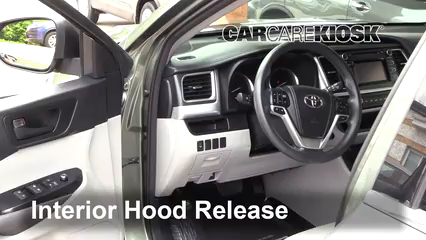

If one or more brake pads are missing their anti-rattle clips, brake chatter often results. Because of this, individual components tend to shift if not fitted in a relatively snug manner. Related: 9 Causes of Steering Wheel Noise When Turning #4 – Poor Fitting Brake ComponentsĪ vehicle’s brake components are placed under a tremendous amount of force when bringing a car or truck to a stop. In most cases, a thorough visual inspection will be necessary to isolate the root cause of such noises. More often than not, worn or damaged brake, steering, or suspension components are to blame. In a number of cases, rattling noises can project from a vehicle’s front end or wheel wells. Replacement is typically necessary if rust has completely compromised a heat shield’s integrity. When a heat shield begins to separate from its mounts, it can either be tack welded into place, or replaced and reattached.
Toyota highlander under hood rattling noise bumpy road free#
In cases such as these, a heat shield can break free from its welds, and be left to vibrate against nearby exhaust components. While heat shields tend to be relatively trouble-free, they are prone to the effects of rust and corrosion. #3 – Damaged Heat ShieldĪ vehicle’s exhaust system is typically clad in numerous heat shields that protect other components from the effects of heat radiation. The root cause of this damage should be diagnosed before unit replacement. However, catalytic converters usually operated without issue, unless damaged by an underlying factor. When a catalytic converter fails, replacement becomes necessary. This noise often sounds like marbles being shaken inside of a can. Unfortunately, these devices can fail at the hands of overheating or impact, causing pieces of their internal structure to break away, and be left to rattle about. Today’s vehicles employ the use of catalytic converters to break down common emissions-related pollutants, turning them into less toxic chemicals. Damaged hangers should be replaced with OEM equivalent parts when needed, as should rusted or otherwise compromised exhaust clamps. Remedying issues of this nature typically involves component replacement. This produces noise that often varies in intensity under acceleration. When this occurs, these vital components can loosen, or decay to the point of failure.Īs a result, excessive vibration can occur. With time, an exhaust system’s hangers and clamps tend to deteriorate, largely at the hands of corrosion. Noises of this nature tend to be most noticeable when a vehicle’s engine is placed under a load, or when accelerating.

The bulk of these noises can be traced back to exhaust related issues. Rattling noises from underneath a vehicle are extremely common. By categorizing your vehicle’s noise as described, you are better able to focus your diagnostic efforts. These categories include underbody rattles, wheel well rattles, under the hood rattles, and interior rattles. The source of vehicle rattles can be easily divided into several different categories. The key to remedying a noise of this nature is to accurately determine its origin, thereby making further inspection possible. Rattling noises can be emitted from nearly any area of your vehicle, with many such noises varying significantly in tone and intensity.


 0 kommentar(er)
0 kommentar(er)
